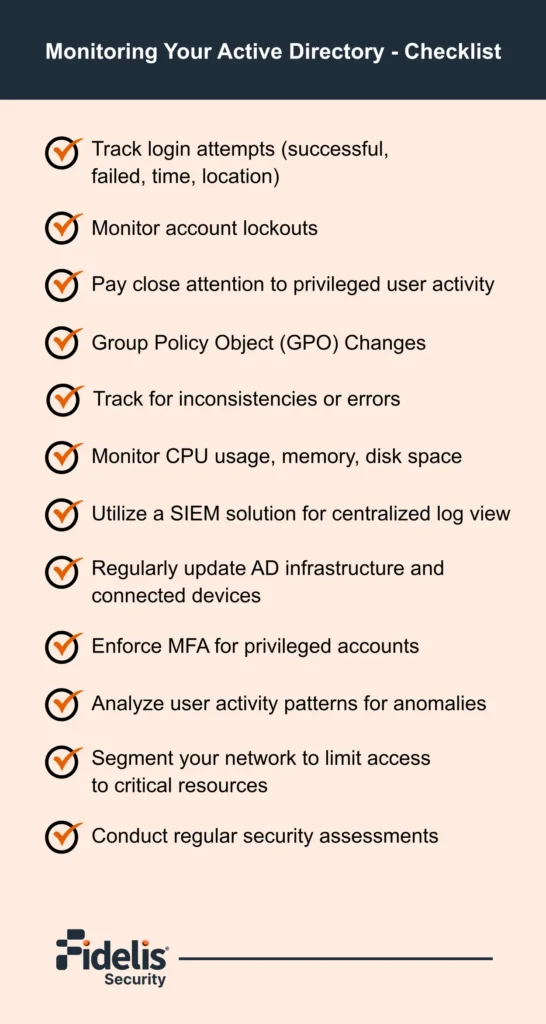Breaking Down the Real Meaning of an XDR Solution
Read More Discover 19 critical, must-know Active Directory security practices and technologies to protect
Cybersecurity Threat Report for 2025: Part 2 – This Research Report is all you need to stay updated.
The digital landscape of today is rapidly evolving, and so are cyberattacks. This means that it is more important than ever to strengthen the security posture of your Active Directory.
Active Directory can be considered as the central nervous system of your organization, granting access to everything from files and printers to critical applications. If compromised, a malicious actor could steal sensitive data, unleash ransomware attacks, or even bring your entire system to a grinding halt.
But we have good news for you! You can take control. A proactive Active Directory (AD) monitoring tool is your best defense against cybercrimes.
This blog offers all the necessary knowledge to maintain the security of Active Directory in 2024.
By following the mentioned steps, you’ll:
Let’s dive in and fortify your digital fortress!
In 2024, Active Directory security is and will face new challenges due to the constantly changing threat landscape. The following points explains why proactive AD monitoring is an essential line of defense and is no longer optional:

Now that you know the importance and benefits of regular monitoring, let’s get down to brass tacks.
It’s time to roll up your sleeves and implement a robust strategy. Here are the essential areas you should focus on to safeguard your AD environment:
This is the first line of defense against unauthorized access and suspicious activities. Here’s what you should pay close attention to:
Login Attempts: Track successful logins, failed attempts, and unusual login times or places. An increase in failed login attempts from a single IP address or login attempts outside of usual business hours could suggest brute-force attacks or stolen credentials.
Account lockouts: Keep track of accounts that are often locked due to failed login attempts. This could be an indication of compromised credentials or automated attacks.
Privileged Users’ Activity: Pay strict attention to any activity by users with administrative privileges. Keep track of password resets, group membership changes, and access to critical data. Any odd activity from privileged accounts must be investigated quickly.
GPOs are used to define security configurations throughout your domain. Monitor any changes made to GPOs to verify that no unauthorized changes occur. Check for any odd changes to access rights, password policies, or security settings.
Replication ensures that data is consistently replicated across all Domain Controllers (DCs) on your network. Monitor replication status for any discrepancies or problems. Unhealthy replication can result in data inconsistencies and security vulnerabilities.
The health of your DCs directly impacts the performance and security of your Active Directory system. Monitor important indicators such as CPU use, memory consumption, and disk space. Performance constraints can slow down authentication operations and provide opportunities for attackers to exploit.
Windows Event Viewer provides valuable insights into security incidents within AD. However, manually sorting through logs might be time-consuming. Consider deploying a SIEM (Security Information and Event Management) solution. SIEM collects logs from multiple sources, such as AD, firewalls, and endpoint devices, and provides a centralized view for faster threat detection and analysis.
Here’s a checklist of the best practices with some additional points:

By bringing these practices into play, you identify suspicious activity before it escalates into a major security incident and ensure the smooth operation of your Active Directory.
To make your AD security strategies impregnable go through our active directory hardening guide or download the whitepaper that explains advanced strategies and pick up on the pointers that fit perfectly with your plan.
Solution: Bring tools together and integrate solutions in one place to make things easier to manage and more transparent, so your team can manage security across multiple domains and sites more effectively.
Solution: You can prioritize the key assets to be monitored, thus enabling a team to focus on those areas of greatest risk and impact.
Solution: Tweak the alerts and filtering anomalies, from low to negligible, using machine learning. It improves accuracy and allows your team to respond to serious risks rather than noise.
Yes, monitoring can help uncover performance issues, optimize processes, and improve user experiences by ensuring that systems work smoothly and efficiently.
Use automated scripts and AD monitoring tools to expedite procedures and save manual labor, resulting in consistent monitoring practices and rapid threat identification.
Track login attempts, account lockouts, and privileged user actions. Regular audits and automated reporting enhance visibility, providing a clear picture of activities and potential threats.
We understand the importance of Active Directory (AD) in your organization’s security posture. Fidelis Active Directory Intercept™ (ADI), an advanced security solution of ours, provides extensive AD monitoring capabilities. It offers features like:
Our solutions integrate easily with your existing security infrastructure, giving you a comprehensive view of your AD environment and allowing you to address threats preemptively.
By implementing a proactive Active Directory monitoring strategy, you gain a significant advantage in the fight against cybercrime. Don’t wait for a breach to occur before you act. Start fortifying your AD security posture today!
Sarika, a cybersecurity enthusiast, contributes insightful articles to Fidelis Security, guiding readers through the complexities of digital security with clarity and passion. Beyond her writing, she actively engages in the cybersecurity community, staying informed about emerging trends and technologies to empower individuals and organizations in safeguarding their digital assets.
See Fidelis in action. Learn how our fast and scalable platforms provide full visibility, deep insights, and rapid response to help security teams across the World protect, detect, respond, and neutralize advanced cyber adversaries.